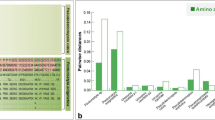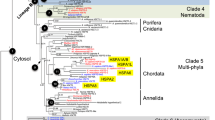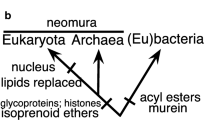Abstract
Most eukaryote molecular phylogenies have been based on small-subunit ribosomal RNA as its database includes the most species, but serious problems have been encountered that can make these trees misleading. More recent studies using concatenated protein sequences have increased the data per organism, reducing misleading signals from a single sequence, but taxon sampling is limited. To increase the database of protein-coding genes we sequenced the cytosolic form of heat-shock protein Hsp90 from a broad variety of previously unsampled eukaryote groups: protozoan flagellates (phyla Choanozoa, Apusozoa, Cercozoa) and all three groups of chromists (Cryptophyta, Heterokonta, Haptophyta). Gamma-corrected distance trees robustly show three groups: bacterial sequences are sister to all eukaryote sequences, which are cleanly subdivided into the cytosolic sequences and a clade comprising the chloroplast and endoplasmic reticulum (ER) Hsp90 sequences. The eukaryote cytosolic sequences comprise a robust opisthokont clade (animals/Choanozoa/fungi), a bikont clade, and an amoebozoan branch. However their topology is not robust. When the cytosolic sequences are rooted using only the ER/chloroplast clade as outgroup the amoebozoan Dictyostelium is sister to the opisthokonts forming a unikont clade in the distance tree. Congruence of this tree with that for concatenated mitochondrial proteins suggests that the root of the eukaryote tree is between unikonts and bikonts. Gamma-corrected maximum likelihood analyses of cytosolic sequences alone (519 unambiguously aligned amino acid positions) show bikonts as a clade, as do least-squares distance trees, but with other distance methods and parsimony the sole amoebozoan species branches weakly within bikonts. Choanozoa are clearly sisters to animals. Some major bikont groups (e.g. green plants, alveolates, Euglenozoa) are consistently recovered, but others (e.g. discicristates, chromalveolates) appear only in some trees; the backbone of the bikont subtree is not resolved, the position of groups represented only by single sequences being particularly unclear. Although single-gene trees will probably never resolve these uncertainties, the congruence of Hsp90 trees with other data is greater than for most other molecules and further taxon sampling of this molecule is recommended.





Similar content being viewed by others
References
JM Archibald T Cavalier-Smith U Maier S Douglas (2001) ArticleTitleMolecular chaperones encoded by a reduced nucleus: the cryptomonad nucleomorph. J Mol Evol 52 490–501 Occurrence Handle1:CAS:528:DC%2BD3MXksFOiur4%3D Occurrence Handle11443352
JM Archibald D Longet J Pawlowski PJ Keeling (2003) ArticleTitleA novel polyubiquitin structure in Cercozoa and Foraminifera: evidence for a new eukaryotic supergroup. Mol Biol Evol 20 62–66 Occurrence Handle10.1093/molbev/msg006 Occurrence Handle1:CAS:528:DC%2BD3sXktlOrsQ%3D%3D Occurrence Handle12519907
MS Atkins AG McArthur AP Teske (2000) ArticleTitleAncyromonadida: A new phylogenetic lineage among the protozoa closely related to the common ancestor of metazoans, fungi, and choanoflagellates (Opisthokonta). J Mol Evol 51 278–285 Occurrence Handle1:CAS:528:DC%2BD3cXnslGltLk%3D Occurrence Handle11029072
SL Baldauf JD Palmer (1993) ArticleTitleAnimals and fungi are each other’s closest relatives: Congruent evidence from multiple proteins. Proc Natl Acad Sci USA 90 11558–11562 Occurrence Handle8265589
S Baldauf AJ Roger I Wenk-Siefert WF Doolittle (2000) ArticleTitleA kingdom-level phylogeny of eukaryotes based on combined protein data. Science 290 972–977 Occurrence Handle10.1126/science.290.5493.972 Occurrence Handle1:CAS:528:DC%2BD3cXnvVWksL0%3D Occurrence Handle11062127
E Bapteste H Brinkmann JA Lee DV Moore CW Sensen P Gordon et al. (2002) ArticleTitleThe analysis of 100 genes supports the grouping of three highly divergent amoebae: Dictyostelium, Entamoeba, and Mastigameoba. Proc Natl Acad Sci USA 99 1414–1419 Occurrence Handle10.1073/pnas.032662799 Occurrence Handle1:CAS:528:DC%2BD38Xht1Cls7c%3D Occurrence Handle11830664
I Bolivar JF Fahrni A Smirnov J Pawlowski (2001) ArticleTitleSSU rRNA-based phylogenetic position of the genera Amoeba and Chaos (Lobosea, Gymnamoebia): The origin of Gymnamoebae revisited. Mol Biol Evol 18 2306–2314 Occurrence Handle1:CAS:528:DC%2BD3MXptFGkur8%3D Occurrence Handle11719580
T Cavalier-Smith (1986) The kingdom Chromista: Origin and systematics. FE Round DJ Chapman (Eds) Progress in phycological research, volume 4. Biopress Ltd Bristol 309–347
T Cavalier-Smith (1994) Origin and relationships of Haptophyta. JC Green BSC Leadbeater (Eds) The haptophyte algae. Clarendon Press Oxford 413–435
T Cavalier-Smith (1997) ArticleTitleSagenista and Bigyra, two phyla of heterotrophic heterokont chromists. Arch Protistenk 148 253–267
T Cavalier-Smith (1998a) Neomonada and the origin of animals and fungi. GH Coombs K Vickerman MA Sleigh GD Warren (Eds) Evolutionary relationships among protozoa. Kluwer London 375–407
T Cavalier-Smith (1998b) ArticleTitleA revised six-kingdom system of life. Biol Rev 73 203–266 Occurrence Handle1:STN:280:DyaK1M%2Fis1Gnsg%3D%3D
T Cavalier-Smith (1999) ArticleTitlePrinciples of protein and lipid targeting in secondary symbiogenesis: Euglenoid, dinoflagellate and sporozoan plastid origins and the eukaryote family tree. J Eukaryot Microbiol 46 347–366 Occurrence Handle1:CAS:528:DyaK1MXlslSksrw%3D
T Cavalier-Smith (2000) Flagellate megaevolution: the basis for eukaryote diversification. JC Green BSC Leadbeater (Eds) The flagellates. Taylor and Francis London 361–390
T Cavalier-Smith (2002) ArticleTitleThe phagotrophic origin of eukaryotes and phylogenetic classification of Protozoa. Int J Syst Evol Microbiol 52 297–353 Occurrence Handle1:STN:280:DC%2BD387pvVekug%3D%3D Occurrence Handle11931142
T Cavalier-Smith (2003) ArticleTitleGenomic reduction and evolution of novel genetic membranes and protein-targeting machinery in eukaryote-eukaryote chimaeras (meta-algae). Phil Trans Roy Soc B 358 109–134 Occurrence Handle10.1098/rstb.2002.1194 Occurrence Handle1:CAS:528:DC%2BD3sXktVWhsro%3D
T Cavalier-Smith EE Chao (1995) ArticleTitleThe opalozoan Apusomonas is related to the common ancestor of animals, fungi, and choanoflagellates. Proc R Soc Lond B 261 1–6
T Cavalier-Smith EE Chao (2003a) ArticleTitleMolecular phylogeny of centrohelid heliozoa, a novel lineage of bikont eukaryotes that arose by ciliary loss. J Mol Evol 56 387–396 Occurrence Handle1:CAS:528:DC%2BD3sXisV2qsbw%3D
T Cavalier-Smith EE Chao (2003b) ArticleTitlePhylogeny of Choanozoa, Apusozoa and other Protozoa and early eukaryote megaevolution. J Mol Evol 56 540–563 Occurrence Handle1:CAS:528:DC%2BD3sXivFygsrc%3D
G De Carcer M do Carmo Avides MJ Lallena DM Glover C Gonzalez (2001) ArticleTitleRequirement of Hsp90 for centrosomal function reflects its regulation of Polo kinase stability. EMBO J 20 2878–2884 Occurrence Handle10.1093/emboj/20.11.2878 Occurrence Handle1:CAS:528:DC%2BD3MXksFGrtrs%3D Occurrence Handle11387220
JD Cechetto RS Gupta (2000) ArticleTitleImmunoelectron microscopy provides evidence that tumor necrosis factor receptor-associated protein 1 (TRAP-1) is a mitochondrial protein which also localizes at specific extramitochondrial sites. Exp Cell Res 260 30–39 Occurrence Handle10.1006/excr.2000.4983 Occurrence Handle1:CAS:528:DC%2BD3cXmvVeitro%3D Occurrence Handle11010808
JB Dacks JD Silberman AGB Simpson S Moriya T Kudo M Ohkuma RJ Redfield (2001) ArticleTitleOxymonads are closely related to the excavate taxon Trimastix. Mol Biol Evol 18 1034–1044 Occurrence Handle1:CAS:528:DC%2BD3MXktFemur8%3D Occurrence Handle11371592
JB Dacks A Marinets FW Doolittle T Cavalier-Smith JM Logsdon Jr (2002) ArticleTitleAnalyses of RNA Polymerase II genes from free-living protists: Phylogeny, long branch attraction, and the eukaryotic big bang. Mol Biol Evol 19 830–840 Occurrence Handle1:CAS:528:DC%2BD38Xks1OjtLc%3D Occurrence Handle12032239
S Douglas S Zauner M Fraunholz M Beaton S Penny LT Deng et al. (2001) ArticleTitleThe highly reduced genome of an enslaved algal nucleus. Nature 410 1091–1096 Occurrence Handle10.1038/35074092 Occurrence Handle1:CAS:528:DC%2BD3MXjsVCrsL0%3D Occurrence Handle11323671
VP Edgcomb AJ Roger AGB Simpson DT Kysela ML Sogin (2001) ArticleTitleEvolutionary relationships among “jakobid” flagellates as indicated by alpha- and beta-tubulin phylogenies. Mol Biol Evol 18 514–522 Occurrence Handle1:CAS:528:DC%2BD3MXis1eisLg%3D Occurrence Handle11264402
VV Emelyanov (2002) ArticleTitlePhylogenetic relationships of organellar Hsp90 homologues reveal fundamental differences to organellar Hsp70 and Hsp60 evolution. Gene 299 125–133 Occurrence Handle10.1016/S0378-1119(02)01021-1 Occurrence Handle1:CAS:528:DC%2BD38XovFSksrc%3D Occurrence Handle12459260
NM Fast JC Kissinger DS Roos PJ Keeling (2001) ArticleTitleNuclear-encoded, plastid-targeted genes suggest a single common origin for apicomplexan and dinoflagellate plastids. Mol Biol Evol 18 418–426 Occurrence Handle1:CAS:528:DC%2BD3MXhvVKrt78%3D Occurrence Handle11230543
NM Fast L Xue S Bingham PJ Keeling (2002) ArticleTitleRe-examining alveolate evolution using multiple protein molecular phylogenies. J Eukaryot Microbiol 49 30–37 Occurrence Handle1:CAS:528:DC%2BD38Xis1eqsro%3D Occurrence Handle11908896
J Felsenstein (2002) PHYLIP (Phylogeny Inference Package) version 3.6a3. Distributed by the author. Department of Genome Sciences. University of Washington Seattle
J Felsenstein GA Churchill (1996) ArticleTitleA Hidden Markov Model approach to variation among sites in rate of evolution. Mol Biol Evol 13 93–104 Occurrence Handle1:CAS:528:DyaK28XhtVylur0%3D Occurrence Handle8583911
WM Fitch E Margoliash (1967) ArticleTitleConstruction of phylogenetic trees. Science 155 279–284 Occurrence Handle1:CAS:528:DyaF2sXnt1Gnsw%3D%3D Occurrence Handle5334057
O Gascuel (1997) ArticleTitleBIONJ: An improved version of the NJ algorithm based on a simple model of sequence data. Mol Biol Evol 14 685–695 Occurrence Handle1:CAS:528:DyaK2sXksVahs7o%3D Occurrence Handle9254330
RS Gupta (1995) ArticleTitlePhylogenetic analysis of the 90 kD heat shock family of protein sequences and examination of the relationships among animals, plants, and fungi species. Mol Biol Evol 12 1063–1073 Occurrence Handle1:CAS:528:DyaK2MXovVOis7g%3D Occurrence Handle8524040
TA Hall (1999) ArticleTitleBioEdit: a user-friendly biological sequence alignment editor and analysis program for Windows 95/98/NT. Nucl Acids Symp Ser 41 95–98 Occurrence Handle1:CAS:528:DC%2BD3cXhtVyjs7Y%3D
DT Jones WR Taylor JM Thornton (1992) ArticleTitleThe rapid generation of mutation data matrices from protein sequences. Comput Appl Biosci 8 275–282 Occurrence Handle1:CAS:528:DyaK38Xlt1Okt7w%3D Occurrence Handle1633570
PJ Keeling (2001) ArticleTitleForaminifera and Cercozoa are related in actin phylogeny: Two orphans find a home? Mol Biol Evol 18 1551–1557 Occurrence Handle1:CAS:528:DC%2BD3MXlslOis7Y%3D Occurrence Handle11470846
PJ Keeling JA Deane GI McFadden (1998) ArticleTitleThe phylogenetic position of alpha- and beta-tubulins from the Chlorarachnion host and Cercomonas (Cercozoa). J Eukaryot Microbiol 45 561–570 Occurrence Handle1:CAS:528:DyaK1cXmvFGmtr0%3D Occurrence Handle9783459
P Krishna G Gloor (2001) ArticleTitleThe Hsp90 family of proteins in Arabidopsis thaliana. Cell Stress Chaperones 6 238–246 Occurrence Handle1:CAS:528:DC%2BD3MXnslKhtbw%3D Occurrence Handle11599565
BF Lang C O’Kelly T Nerad WM Gray G Burger (2002) ArticleTitleThe closest unicellular relatives of animals. Curr Biol 12 1773–1778 Occurrence Handle10.1016/S0960-9822(02)01187-9 Occurrence Handle1:CAS:528:DC%2BD38Xot1ags7c%3D Occurrence Handle12401173
D Moreira H Le Guyader H Philippe (2000) ArticleTitleThe origin of red algae and the evolution of chloroplasts. Nature 405 69–72 Occurrence Handle10.1038/35011054 Occurrence Handle1:STN:280:DC%2BD3c3mvFemtA%3D%3D Occurrence Handle10811219
T Morita A Amagai Y Maeda (2002) ArticleTitleUnique behavior of a Dictyostelium homologue of TRAP-1, coupling with differentiation of D. discoideum cells. Exp Cell Res 280 45–54 Occurrence Handle10.1006/excr.2002.5620 Occurrence Handle1:CAS:528:DC%2BD38XnsVanurs%3D Occurrence Handle12372338
H Philippe P Lopez H Brinkmann K Budin A Germot J Laurent et al. (2000) ArticleTitleEarly-branching or fast-evolving eukaryotes? An answer based on slowly evolving positions. Proc R Soc Lond B 267 1213–1221 Occurrence Handle10.1098/rspb.2000.1130 Occurrence Handle1:CAS:528:DC%2BD3cXlsFyqtLo%3D Occurrence Handle10902687
H Philippe A Adoutte (1998) The molecular phylogeny of Eukaryota: Solid facts and uncertainties. GH Coombs K Vickerman MA Sleigh A Warren (Eds) Evolutionary relationships among protozoa. Kluwer London 25–56
C Queitsch TA Sangster S Lindquist (2002) ArticleTitleHsp90 as a capacitor of phenotypic variation. Nature 417 618–624 Occurrence Handle12050657
AJ Roger (1999) ArticleTitleReconstructing early events in eukaryotic evolution. Am Nat 154 S146–S163 Occurrence Handle10.1086/303290 Occurrence Handle10527924
SL Rutherford S Lindquist (1998) ArticleTitleHsp90 as a capacitor for morphological evolution. Nature 396 336–342 Occurrence Handle1:CAS:528:DyaK1cXnvVaksLY%3D Occurrence Handle9845070
A Rzhetsky M Nei (1992) ArticleTitleStatistical properties of the ordinary least-squares, generalized least-squares, and minimum-evolution methods of phylogenetic inference. J Mol Evol 35 367–375 Occurrence Handle1:CAS:528:DyaK38Xmt12mt7c%3D Occurrence Handle1404422
HA Schmidt K Strimmer M Vingron A von Haeseler (2002) ArticleTitleTREE-PUZZLE: Maximum likelihood phylogenetic analysis using quartets and parallel computing. Bioinformatics 18 502–504 Occurrence Handle10.1093/bioinformatics/18.3.502 Occurrence Handle1:CAS:528:DC%2BD38XivFKrsL0%3D Occurrence Handle11934758
G Schmitz M Schmidt J Feierabend (1996) ArticleTitleCharacterization of a plastid-specific HSP90 homologue: Identification of a cDNA sequence, phylogenetic descendence and analysis of its mRNA and protein expression. Plant Mol Biol 30 479–492 Occurrence Handle1:CAS:528:DyaK28XhvFyhu74%3D Occurrence Handle8605300
JD Silberman AGB Simpson J Kulda I Cepicka V Hampl PJ Johnson AJ Roger (2002) ArticleTitleRetortamonad flagellates are closely related to diplomonads—implications for the history of mitochondrial function in eukaryote evolution. Mol Biol Evol 19 777–786 Occurrence Handle1:CAS:528:DC%2BD38XjsFaku7Y%3D Occurrence Handle11961110
AGB Simpson DJ Patterson (2001) ArticleTitleOn core jakobids and excavate taxa: the ultrastructure of Jacoba incarcerata. J Eukaryot Microbiol 48 480–492 Occurrence Handle1:STN:280:DC%2BD38%2FitFGmsA%3D%3D Occurrence Handle11456326
AGB Simpson J Lukes AJ Roger (2002) ArticleTitleThe evolutionary history of kinetoplastids and their kinetoplasts. Mol Biol Evol 19 2071–2083 Occurrence Handle1:CAS:528:DC%2BD38Xps12hsrk%3D Occurrence Handle12446799
AGB Simpson AJ Roger (2002) ArticleTitleEukaryotic evolution: Getting to the root of the problem. Curr Biol 12 R691–R693 Occurrence Handle10.1016/S0960-9822(02)01207-1 Occurrence Handle1:CAS:528:DC%2BD38Xot1agsrs%3D Occurrence Handle12401185
SW Smith R Overbeek CR Woese W Gilbert PM Gillevet (1994) ArticleTitleThe genetic data environment and expandable GUI for multiple sequence analysis. Comput Appl Biosci 10 671–675 Occurrence Handle7704666
EA Snell RF Furlong PWH Holland (2001) ArticleTitleHsp70 sequences indicate that choanoflagellates are closely related to animals. Curr Biol 11 967–970 Occurrence Handle10.1016/S0960-9822(01)00275-5 Occurrence Handle1:CAS:528:DC%2BD3MXltVGjtb0%3D Occurrence Handle11448773
V Sollars X Lu L Xiao X Wang MD Garfinkel DM Ruden (2003) ArticleTitleEvidence for an epigenetic mechanism by which Hsp90 acts as a capacitor for morphological evolution. Nat Genet 33 70–74 Occurrence Handle10.1038/ng1067 Occurrence Handle1:CAS:528:DC%2BD38XpvVeqs7c%3D Occurrence Handle12483213
A Stechmann T Cavalier-Smith (2002) ArticleTitleRooting the eukaryote tree by using a derived gene fusion. Science 297 89–91 Occurrence Handle10.1126/science.1071196 Occurrence Handle1:CAS:528:DC%2BD38XltFGntrw%3D Occurrence Handle12098695
DL Swofford (1998) PAUP*. Phylogenetic analysis using parsimony (*and other methods). Version 4. Sinauer Associates Sunderland, MA
JD Thompson TJ Gibson F Plewniak F Jeanmougin DG Higgins (1997) ArticleTitleThe ClustalX windows interface: Flexible strategies for multiple sequence alignment aided by quality analysis tools. Nucleic Acids Res 24 4876–4882 Occurrence Handle10.1093/nar/25.24.4876
Z Yang (1995) ArticleTitleA space-time process model for the evolution of DNA sequences. Genetics 139 993–1005 Occurrence Handle1:CAS:528:DyaK28XhsFWgtL8%3D Occurrence Handle7713447
HS Yoon JD Hackett G Pinto D Bhattacharya (2002) ArticleTitleThe single, ancient origin of chromist plastids. Proc Natl Acad Sci USA 99 15507–15512 Occurrence Handle10.1073/pnas.242379899 Occurrence Handle1:CAS:528:DC%2BD3sXjvVOg Occurrence Handle12438651
JC Young I Moarefi FU Hartl (2001) ArticleTitleHsp90: a specialised but essential protein-folding tool. J Cell Biol 154 267–273 Occurrence Handle1:CAS:528:DC%2BD3MXlsVOjs7k%3D Occurrence Handle11470816
JC Young NJ Hoogenraad FU Hartl (2003) ArticleTitleMolecular chaperones Hsp90 and Hsp70 deliver preproteins to the mitochondrial import receptor Tom70. Cell 112 41–50 Occurrence Handle1:CAS:528:DC%2BD3sXmtFGgsw%3D%3D Occurrence Handle12526792
Acknowledgements
We thank A. Simpson for providing the kinetoplastid Hsp90 sequences prior to publication and J. Archibald for the initial protein alignment of Hsp90 sequences. TCS thanks NERC UK for a research grant and the Canadian Institute for Advanced Research and NERC for fellowship support.
Author information
Authors and Affiliations
Corresponding author
Rights and permissions
About this article
Cite this article
Stechmann, A., Cavalier-Smith, T. Phylogenetic Analysis of Eukaryotes Using Heat-Shock Protein Hsp90 . J Mol Evol 57, 408–419 (2003). https://doi.org/10.1007/s00239-003-2490-x
Received:
Accepted:
Issue Date:
DOI: https://doi.org/10.1007/s00239-003-2490-x




